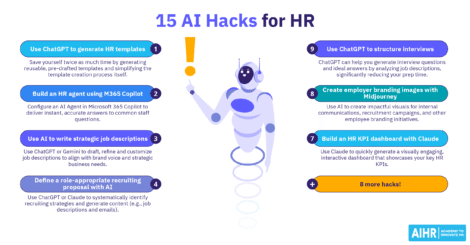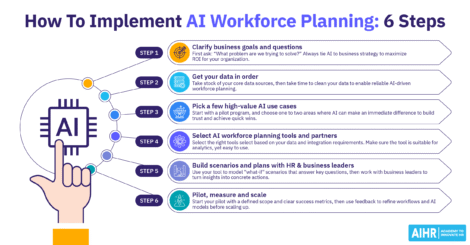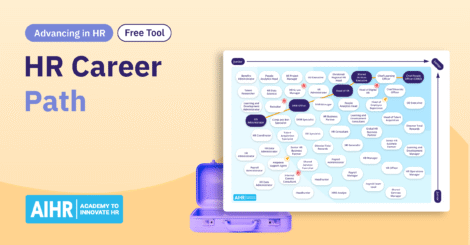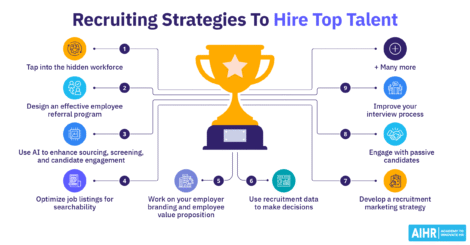Despite all the buzz about AI, Mercer research shows that only 14% of companies have fully integrated it into their talent acquisition tech stack. Learning how to use ChatGPT for recruiting can be the first step in harnessing the benefits of generative AI. For talent acquisition and HR professionals, it streamlines work by automating tasks such as drafting communications, writing job descriptions, and creating interview questions, while also providing candidate insights in seconds.
In this article, we will explore ChatGPT’s role in recruitment. You will find tips on when and how to use (and not use) it, along with 20 practical prompts for different stages of the hiring process.
For even more ready-to-use prompts tailored for HR, download our ChatGPT Prompts for HR Guide and streamline your workflow today.

Contents
How to use ChatGPT for recruiting: Tips
20 ChatGPT prompts for recruiters
1. Preparing
2. Sourcing
3. Screening and selecting
4. Hiring
5. Onboarding
How to use ChatGPT for recruiting: Tips
Before we get into specific prompts, let’s look at some practical ways to make the most of ChatGPT in your recruitment process:
- Be specific: Make your prompts as precise and detailed as possible to avoid generic answers. Providing context and an objective is especially important for writing effective recruiting prompts for ChatGPT.
- Give ChatGPT a role to play: Frame the interaction instead of simply asking the tool to produce text. Assigning ChatGPT a role improves the relevance and tone of its responses. For instance, you could say, “You are a tech recruiter at a SaaS company looking for a mid-level UX designer for a remote position. Write a job ad that appeals to candidates who prioritize accessibility and design systems.”
- Iterate and refine: Try different prompt styles, ask follow-up questions, and provide extra instructions to get deeper results. Keep updating your prompts as your recruitment strategy and hiring standards evolve.
- Avoid entering candidate data: Do not include candidate names or other personal information unless you are certain about how the data will be stored and processed. This helps you avoid privacy and compliance risks.
- Always review and edit the results: AI-generated text should never be used without human oversight. Check the accuracy, adjust the tone, and make sure the content meets legal and organizational requirements before using it.
- Experiment with different recruitment tasks: ChatGPT can support many aspects of hiring. Try it for writing job ads and social media posts, drafting outreach emails, or generating role-specific interview questions. Test what works best for your team and adapt as needed.
- Watch for misinterpretation of legal and industry terms: ChatGPT can misuse technical jargon or HR terminology. Always double-check how it handles sensitive terms like “at-will employment,” “reasonable accommodation,” or “exempt status,” especially in legal or compliance-related documents.

Since much of your recruitment activity is visible externally, the way you use ChatGPT can affect your employer brand. With that in mind, here are a few more factors to consider before adopting the tool:
- Don’t use ChatGPT to make final selections: If the use of an AI-powered tool results in an adverse discriminatory impact, the employer can be held liable. Take note that in early 2025, the U.S. Equal Employment Opportunity Commission (EEOC) and U.S. Department of Labor rescinded the previous guidance for AI and workplace discrimination, which was based on a 2023 executive order. However, employers must still comply with EEOC non-discrimination hiring policies.
- Determine the appropriate use of ChatGPT: The fact that you can use ChatGPT for certain tasks doesn’t mean that you necessarily should. Before rolling it out, align with your team on which recruitment tasks the tool will handle and which should remain fully human-driven. ChatGPT works best for repetitive tasks like drafting initial communications, while evaluations and hiring decisions should stay in human hands.
- Keep it personal: During the sourcing stage, reaching out to potential candidates with a relevant, fine-tuned message is crucial. Generic messages that are obviously generated by an AI-driven tool like ChatGPT can be off-putting for candidates, whether it’s an outreach, offer, or salary negotiation email. Candidates who sense a lack of personalization may feel undervalued, lose interest in the role, or even share negative feedback online, which can hurt your employer brand.
HR tip
Stay informed about state and local regulations on AI in hiring. For example, New York City requires employers using automated employment decision tools to notify candidates and conduct annual third-party bias audits to show how the technology may disadvantage certain groups.
20 ChatGPT prompts for recruiters
Recruiters and talent acquisition professionals can use ChatGPT to streamline various tasks across the stages of the hiring process:
Let’s walk through 20 examples of ChatGPT prompts across these five stages, along with guidance on how to apply them in your own context.
Preparing
1. Writing a job description
| Sample prompt: “Generate a detailed job description for a Data Scientist position with a focus on machine learning and AI. The description should include a job overview, key responsibilities, required skills and qualifications, and information about the team.” |
What you need to know
This prompt will provide a draft job description that can be shared internally between the recruiter and the hiring manager to confirm alignment on the ideal candidate profile. Use the AI-generated version as a starting point and refine it into the final job description.
2. Analyzing a job description
| Sample prompt: “Analyze the following job description for an Executive Assistant at the corporate office of a multi-national consumer goods company. Identify and list the key responsibilities, required skills or qualifications, and attributes for success in this role. Highlight any industry-specific terminology and recommend ways to improve the job description for clarity or inclusivity.” |
What you need to know
Job descriptions need to keep pace with evolving organizational objectives and business needs. ChatGPT can help by identifying missing details, vague requirements, or biased language. You can also make job descriptions more tailored by prompting the tool to highlight specific competencies, ideal candidate profiles, and your organization’s values.
3. Creating a job ad
| Sample prompt: “Compose a compelling job advertisement for a Senior Web Developer position at a fast-growing e-commerce startup. The ad should include an enticing headline, an overview of the role, key responsibilities, necessary skills and qualifications, and the perks of working at our company. Use language that is inclusive and appealing to a diverse audience.” |
What you need to know
This prompt gives you a template to use as the basis for your specific job ad. Add your company’s name, location, incentives, and unique perks to make it more specific. For a stronger response, include a short description of your company culture and the team the new hire will join.
In addition, you can make your job ad SEO-friendly by fleshing out the prompt further: “Include relevant industry and job-specific keywords to improve visibility and discoverability online.”
Master the use of AI to streamline recruitment
As AI becomes increasingly prevalent in all aspects of business, you must take advantage of the opportunity to use it to streamline your recruitment process.
✅ Apply an AI adoption framework to transform HR processes like recruitment
✅ Learn how to use ChatGPT to create job descriptions that draw top talent
✅ Explore how AI can impact HR productivity and hiring decisions
✅ Develop and execute an AI strategy for business success
🎓 Future-proof your HR function with a flexible, online Artificial Intelligence for HR Certificate Program.
Sourcing
4. Boolean string generation
| Sample prompt: “Create a Boolean search string to find resumes of Software Engineers experienced in Java. The candidates should have a bachelor’s degree in computer science and at least 5 years of experience. They should also be familiar with Agile methodologies and have skills in SQL and RESTful APIs. Exclude candidates who are only experienced in Python or who live outside the United States.” |
What you need to know
Boolean search methods can be a valuable addition to your sourcing toolkit. With this prompt, ChatGPT can generate a starting string that helps you narrow results to more relevant candidates. Depending on the platform or search engine you use, you may need to make small adjustments.
For greater accuracy, research how Boolean search works on the platform you plan to use and then ask ChatGPT to adapt the string accordingly.
5. Finding alternative job titles for sourcing
| Sample prompt: “Generate a list of alternative job titles or roles related to a Social Media Manager position. These should be titles that might be used by professionals with skills in social media strategy, content creation, audience engagement, and analytics, which are typically required for a Social Media Manager role.” |
What you need to know
Alternative job titles are especially useful in today’s hiring landscape, where companies often use different titles for very similar roles. Identifying these variations helps you reach a wider pool of qualified candidates faster, which is particularly valuable when sourcing for hard-to-fill positions.
6. Candidate outreach emails
| Sample prompt: “Craft a personalized candidate outreach email for a potential candidate named John, who is currently a Senior Graphic Designer at a well-known digital marketing agency. The purpose of this email is to invite him to consider an open role for an Art Director at our innovative advertising firm. Highlight our creative environment, professional growth opportunities, and competitive benefits package. The tone should be professional yet friendly.” |
What you need to know
This type of prompt will give you a ready-to-use draft outreach email. Aside from adding company-specific details such as your name, role, or benefits, the text may only need light editing. To get a fuller version, you can refine your prompt with more details about the role, team, or culture.
That said, automatically generated outreach messages can sometimes feel generic. If candidates sense they are receiving a mass email, they may lose interest. Since many recruiters already rely on templates, this might not seem like a major issue, but the best approach is somewhere in between. Use ChatGPT to generate a strong structure, then personalize it with details that show a genuine interest in the candidate.

7. LinkedIn posts
| Sample prompt: “Write an engaging LinkedIn post announcing an open role for a Project Manager at our dynamic tech startup. The post should emphasize the key responsibilities of the role, desired skills, and how the position fits into our organization’s mission. Encourage interested professionals to apply and share the opportunity within their network. The tone should be engaging and inviting.” |
What you need to know
To make your LinkedIn posts stand out, fine-tune the draft by including specific responsibilities and skills. While personalization is less critical here than in outreach emails, you still want your post to feel authentic. Remember that other employers may also be using ChatGPT, so adding your organization’s unique style is important.
If your company has a recognizable tone of voice or distinct branding, incorporate it into the prompt. For example, Spotify refers to its employees as band members and weaves this language consistently into candidate communications.
HR tip
You can train ChatGPT to match your company’s voice by including it in the prompt.
Prompt example: “Our brand tone is plain English, familiar, respectful, and inclusive. Rewrite this email to match.”
8. Job market research
| Sample prompt: “I’m conducting market research for hiring a Digital Content Creator in the hospitality industry. Provide current data and insights on talent availability, active and passive candidate sources, salary trends, and hiring strategies used by leading companies. Recommend credible sources or platforms that offer detailed and updated information related to these topics.” |
What you need to know
ChatGPT can deliver helpful insights into the talent market, including salary benchmarks and common hiring strategies. These outputs can guide you toward more targeted sourcing by pointing to competitors, adjacent industries, niche communities, and educational institutions.
The more detailed and specific your prompt, the better the results will be. Well-structured prompts maximize ChatGPT’s ability to surface relevant and actionable information.
Screening and selecting
9. Providing pre-interview briefings to candidates
| Sample prompt: “Compose a pre-interview briefing email for a candidate named Susan, who has been shortlisted for a Senior Data Analyst position in our organization. Explain the stages of our interview process, which are a technical interview with the hiring manager and a peer interview with two team members, potential areas of focus based on the role (like her experience with data modeling, statistical analysis, etc.), and any logistical details such as interview duration, platform (if virtual), or location. The tone should be supportive and professional to help alleviate any pre-interview anxieties.” |
What you need to know
This prompt provides you with a clear pre-interview briefing email. It is well-structured and ticks all the boxes. Based on your personal preferences, you can shuffle the various paragraphs around to restructure the email.
To provide the candidate with additional details and make the email even more personal, you can add the names of the hiring manager and the two team members they will be interviewing with. This also allows the candidate to research the interviewers on LinkedIn, for example, to better prepare for the interviews.
Here, too, you can add company nuances to the email to further customize it.
10 & 11. Interview questions by role and interview type
| Sample prompt: “Generate a set of 7 behavioral interview questions tailored for a Software Engineer role. These questions should assess the candidate’s problem-solving abilities, teamwork skills, and how they handle deadlines and project pressures.” |
| Sample prompt: “Create a list of 5 technical interview questions for a Digital Marketing Specialist position. The questions should focus on the candidate’s proficiency in SEO/SEM, email marketing, social media marketing, and their familiarity with marketing analytics tools.” |
What you need to know
ChatGPT is great for inspiration and idea generation to get you off to a quick start in creating question lists. You can use follow-up questions to delve deeper into areas like a candidate’s problem-solving abilities or their capacity to work with a cross-functional team – whatever aspect you want to focus on during the interview.
12. Evaluation criteria
| Sample prompt: “Review this job description for a Customer Experience Manager as if you were an experienced recruiter. [Insert job description]. Identify the essential competencies required, including both technical and soft skills. Generate a list of evaluation criteria to assess these skills effectively. The criteria must be definitive, objective, and tailored to the role.” |
What you need to know
ChatGPT’s ability to automate job evaluation criteria design, such as creating scorecards or rubrics, not only saves HR staff time but also standardizes evaluation frameworks for more consistency and impartiality in ranking candidates.
13. Summarize interview feedback
| Sample prompt: “Here is the feedback from multiple interviewers regarding a candidate for a Sales Coordinator position. Act as an experienced recruitment professional who maintains a neutral, concise tone. Summarize the findings by: • Top strengths • Areas for improvement • Average/consensus ratings or scores • Concerns or red flags • An overall recommendation (pass/hold/fail) based on feedback data Interviewer notes: [Insert notes here] |
What you need to know
Structured input helps ChatGPT produce the most effective, comprehensive output. Ensure interviewers express their feedback in a well-defined format, such as:
- Candidate name
- Position applied for
- Skills/competencies assessed
- Ratings
- Notes
- Decision recommendation.
You can also ask ChatGPT to format the feedback results in tables or executive summary paragraphs.
14. Work test check
| Sample prompt: “Complete the following work test as if you were a job candidate for an X role: …” |
What you need to know
This particular application of ChatGPT for recruiting demonstrates how this tool has benefits and drawbacks for both candidates and employers.
Just as candidates tend not to appreciate receiving ChatGPT-generated outreach emails, offer emails, or salary negotiation emails, employers also don’t like receiving cover letters, CVs, and work tests that are completed using only generative AI.
ChatGPT can improve the design of candidate work tests. If a work test can be completed using only generative AI, then you know it needs to be revamped to be more specific and practical.
It might be worth considering creating a “Candidate Code of Conduct” to share with candidates at the start of the hiring process, explaining the company’s policy for using generative AI for application documents and work tests.
This is also a reminder to all of us in HR that we should not rely solely on methods for communicating with candidates that we don’t want them to rely on. This means that we should not send them purely ChatGPT-generated emails if it bothers us to receive ChatGPT-generated application materials and work tests.
15. Generating rejection emails
| Sample prompt: “Draft a respectful and empathetic rejection email for a candidate named Alex, who recently interviewed for the role of Product Manager but was not selected for the position. The email should express our appreciation for Alex’s time, note that it was a competitive process, and encourage him to apply for future roles that match his skills and interests.” |
What you need to know
This prompt generates a template that you can use as the basis for your rejection emails. Details such as the name of your company and contact information still need to be added. Other than that, this template is almost ready-to-use.
You may wonder why we are not emphasizing the importance of personalization here as we did with the candidate outreach email. Rejection emails can be tricky to get right since:
- You don’t want to write anything that could be interpreted as potentially discriminatory.
- You don’t want to mention other candidates.
- You want to be considerate, etc.
So, a template for rejection emails that has been validated by your organization’s legal department is the safest way to go. You should always thoroughly read the email before sending it to ensure it does not mention anything that doesn’t apply to this particular candidate.
Hiring
16. Offer email
| Sample prompt: “Compose an offer letter email for a candidate named Sam, who has been selected for the role of Senior UX Designer at our company. The email should express our excitement about potentially bringing Sam on board, provide the main terms of the offer (including salary, benefits, start date), and explain the next steps for acceptance. The tone should be professional, yet enthusiastic and welcoming.” |
What you need to know
Using this prompt will provide you with a good template for your offer emails. Make sure to have your legal department validate the template before you start sending out offer emails based on it.
There is, however, a bit more room and need for personalization here than with the rejection email. After all, you are welcoming a new team member into the company, something that should always have a noticeable human touch.
17. Salary negotiation email
| Sample prompt: “Create a professional and empathetic response to a candidate named Lisa who has asked for a higher salary than what we’ve offered for the role of Financial Analyst. The email should express our understanding of her concerns, reiterate the comprehensive benefits of our package beyond just the base salary, and state our willingness to engage in further negotiations or explore other ways to meet her expectations.” |
What you need to know
This prompt provides a solid basis for a salary negotiation email. You still need to add the company name and specific benefits, as well as the name of the HR representative that Lisa can reach out to discuss her salary expectations. You should also expand on the more incentivizing aspects of the compensation package in more detail.
Onboarding
18. Onboarding checklist
| Sample prompt: “Design a first-week onboarding checklist for a Marketing Specialist joining a tech startup, including required paperwork, introductions, training, and equipment setup.” |
What you need to know
Although ChatGPT can generate a prototype onboarding checklist, every organization has unique considerations for processing new hires and acclimating them to their roles. Be certain to collaborate with department heads, IT, and other pertinent teams to verify that the checklist is correct and complete. Also, ensure the wording of the checklist directions maintains a welcoming tone that aligns with your company culture.
ChatGPT can help you relay to new hires what they can expect throughout the entire onboarding journey, including preboarding, first day, first week, and first month checklists.
19. New hire FAQ
| Sample prompt: “Generate a list of 10 frequently asked questions by new hires to be posted on our company’s intranet. This should cover common questions new employees might have, such as understanding their benefits, how to set up their email and other IT systems, details about the onboarding process, who to contact for specific queries, information about company culture and values, time-off policies, and any details about day-to-day operations they should be aware of.” |
What you need to know
This prompt gives you a good idea of the most common questions new hires might have. You can further customize the prompt by including a specific type of role or the industry your organization is in.
20. New hire survey questions
| Sample prompt: “Create a set of 7 survey questions to gather feedback from new hires about their onboarding experience. The questions should cover areas like the effectiveness of the orientation program, clarity of job responsibilities and expectations, their initial impressions about the work culture, how supported they felt during their first few weeks, and any suggestions they might have for improvement. The goal is to gauge their initial experiences and find ways to improve the onboarding process.” |
What you need to know
Using this prompt will help you brainstorm the different kinds of questions to ask in your onboarding survey. Adding criteria, for example, “Include at least one question about the support they received from their onboarding buddy,” will help you to further customize the survey questions.
Key takeaways
By clearing the clutter of administrative tasks, ChatGPT empowers recruitment professionals to focus on engaging candidates, supporting hiring managers, and making informed hiring decisions with greater ease and impact.
As useful as ChatGPT is, implementing it for the most effective talent acquisition at your organization requires careful consideration and input from other departments, i.e., broader HR, Legal, and IT. And remember, ChatGPT for recruiting should always be the starting point, with human review and input making up the final product.


















